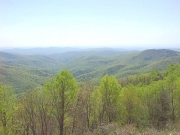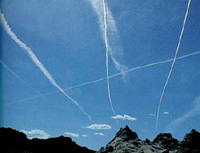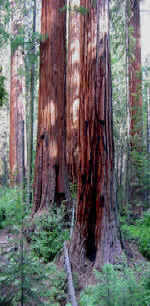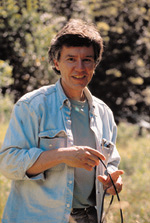The
Soundprints Of Science
By Elizabeth F. van Mantgem
Conservation Biologist, Sequoia and Kings Canyon National Parks.
Assessing
the Natural Soundscape through Biophony
Faster than the extinction of species, natural sounds are disappearing from
our last remaining wild areas. A person who's most concerned about the loss
is the well-known artist and researcher, Dr. Bernie Krause (best known as
front man for the 1960's folk group, The Weavers, right after Pete Seeger).
Because he's been recording natural sounds for the better part of his 63 years,
he's become acutely tuned into the deterioration of biophony, or natural orchestras,
throughout the world. Now he's bringing his expertise to the National Park
System (NPS), and assisting with a mandated project for preserving the natural
sounds, or soundscapes, of some of your favorite natural areas, starting with
Sequoia National Park.
 |
| The
Blue Ridge Parkway: an endangered soundscape? NPS photo |
National Park
Orders
In direct violation of the 1916 NPS Organic Act, many parks are probably losing
biodiversity and ecosystem integrity through exposure to incessant, manmade
sounds. An example of these noise-troubled places is the Blue Ridge Parkway
of Virginia, where you'll hear automobile noise in constant accompaniment
to birds and other wildlife. Elliott Key of Florida's Biscayne National Park
is another noise pollution victim, where motorboats, air conditioners, and
power generators create a white noise that drowns the sounds of the ocean.
In parks and natural areas everywhere, the human sounds of airplanes, jet
skis, power boats, traffic, racetracks, and snowmobiles have invaded otherwise
pristine habitats and altered animal behavior with their echoing engine noises.
In response, the NPS issued Director's Order No. 47, the general instructions
for Soundscape Preservation and Noise Management within our country's National
Parks. A statistic cited within the order as justification for its creation
was the discovery that, after a park-wide survey, 91% of visitors said they
came to parks, "to enjoy the natural soundscape." That's significantly
close to the 93% who come to view the scenery.
This simple statistic
illustrates that in letting the soundscape deteriorate, the NPS would fail
to fulfill its central mission, to preserve all natural and cultural resources
for the future and future generations. The only problem in preserving or even
restoring the natural soundscape is in deciding which sounds are natural.
When asked whether manmade sounds can ever be part of the natural soundscape,
Dr. Krause responded, "Of course. But we must learn the extent to which
they have, or don't have, an impact on the biophony." Subsequently, Order
#47 also requires parks to first assess baseline acoustic conditions, and
then to pick out the good and the bad sounds, one by one. Management will
then deal appropriately with the bad sounds, perhaps by collaborating with
noisy neighbors (like military bases and auto race tracks) or by limiting
park use.
The Project: Aesthetically and Statistically Pleasing
The order holds National Parks responsible for assessing baseline acoustic
conditions, but there's no standard for doing this. Creating a standard, or
sound index and methodology, is why Dr. Krause has been recording sounds in
Sequoia National Park through 2001 and 2002.
 |
| However
remote the landscape, we are never far from jet noise. NASA photo |
"We picked
Sequoia because we were hoping to find a park that, unlike Yosemite, tended
to have fewer visitors, thinking it would be more quiet." Bernie muses,
"This turned out to be only partly true. We certainly didn't anticipate
military jets flying overhead inbound and outbound from Lemore NAS in the
valley at about 15,000 feet on training exercises every 6 or 7 minutes. But
our first field recording date occurred in October, 2001, shortly after 9/11
and we had to learn to live with the impact of incessant jet noise on our
efforts."
Even with the unforeseen jet noise, Dr. Krause reports that recording was
overwhelmingly successful, "We collected excellent data, useful beyond
the scope of our original expectations. But it's hardly a dent in the surface
of what we need to collect and review. Furthermore, new analysis techniques
subsequently developed by my colleague, Dr. Stuart Gage from the Michigan
State University Envirosonics Lab, will reveal even more important detail
when it is finally implemented and used to analyze our data. The first 70
page draft of the analysis has been completed and was submitted for a first
run peer review. As soon as we get a response as to what we've offered, we'll
be conforming it into a final document."
The pilot project's deliverables will be a representative soundprint database
for each of a variety of relatively pristine habitats in Sequoia National
Park, plus a complete methodology to use in parks all over the country. Expert
ornithologists, entomologists, and other biologists are assisting in the identification
soundprint sample sounds. The unadulterated, natural sounds of Sequoia National
Park will then be used to calibrate the sound and health of other parks around
the country. According to Dr. Krause, "we hope to introduce new automated
monitoring technologies and techniques that would allow data collection over
a wide range of parks and at many sites within each one. We hope the results
will be useful over a wide range of applications. Among them, the density
of vocal creature populations, their distribution within a biome, the health
status of the habitat, and the diversity of vocal creatures. Once a biophonic
base line is established, we hope to use variations as a barometer for changes
in status and to find new ways to evaluate habitat dynamics."
 |
| Forest
primeval. Can both ecosystem and soundscape be preserved? Photo by Stephan Hayden |
The specific
sites chosen for recording include: Shepherd's Saddle, a chaparrel ecosystem;
Sycamore Creek, a mixed oak woodland habitat; and Crescent Meadow, an old
growth forest habitat in the Giant Forest. According Krause, "There really
was no difficulty,[in choosing the sites] at all. We had excellent input from
park staff, especially Dave Graber and Annie Esperanza, and established our
criteria early. We looked for four distinctive types of habitat at different
altitudes. Each one needed to be accessible during all four seasons. During
our winter session in January, Jack Hines, one of our field associates, and
I snowshoed several miles with 60 pound packs and winter camped at Crescent
Meadow in order to capture the winter soundscapes at that site."
So the locations were chosen for their biological uniqueness and their convenience.
Each habitat was monitored once for each season of the year and recorded.
The result is four, one-hour recordings segmented into 1-minute segments,
the subsamples used for intra-temporal comparison. The whole point is to get
some good, representative samples of biophony (nature orchestras unique to
specific habitats) with all its variability in each soundscape. This means
that frogs, birds, insects, wind, and even running water was recorded as part
of this beautiful music. Whatever was out there, naturally making noise became
a part of the biophonic data. When the orchestras were transcribed onto paper,
they became quantifiable soundprints, precisely measured sound samples. Several
soundprint samples were then used to represent a habitat in time and space,
an aesthetically pleasing as well as a statistically quantifiable methodology.
The results should be both interesting and useful, as well as cutting-edge.
Listen to to a sample recording of a natureal soundscape: dawn.mp3
(472K) ©2001 Wild
Sanctuary, Inc. All rights reserved.
Dr. Bernie Krause & His Big Ideas
 |
| Dr. Bernie Krause |
Because he's a celebrity, Bernie Krause is not your average scientist. Popularly known for his musical talent and technically known within the music industry for introducing the Moog to pop music and film (late 1960's), his fame precedes him wherever he goes. His resume is extensive, demonstrating the bountiful bioacoustic experiences he's acquired through music, film, and research. Not only has he contributed to the soundtracks of 160 major, feature films (i.e. The Graduate, Cool Hand Luke, Point Blank, and Apocalypse Now, to name a few) and collaborated on recordings with more than 75 successful musicians, he has also created over 10 successful albums for The Nature Company, conducted world-wide sound gathering expeditions in primate habitats, and studied whale behavior related to changing acoustic environments. If you go to any number of natural history museums and aquaria in the U.S., you may get to hear Dr. Krause's recorded natural soundscapes set into various dioramas and displays, like the penguin exhibit at the California Academy of Sciences or the Rainforest in the Cleveland Metroparks Zoo.
When asked if he's still recording music, Dr. Krause responded, "No. Gave that up in 1980. Now and then I can be heard humming or whistling in the shower...but only for our cats, Yo Yo Meow or Eddie Puss Rex, great musicians in their own right(s)."
Currently, Dr.
Krause is President and Director of Wild Sanctuary, Inc. (1968-Present; www.wildsanctuary.com),
a company devoted to recording and analyzing terrestrial and marine sounds,
designing audio exhibits and sound sculpture, and conducting audio forensics.
His concern over acoustic degradation has led him to publish and speak extensively
on the topic. Obviously, Dr. Krause observes the world from a refreshingly
different angle than the rest of us. His is the perspective that diminished
sound diversity negatively affects biodiversity and healthy animal behavior.
In his words, "Sound diversity is important because it represents one
of the many perspectives from which to examine the dynamics within an entire
soundscape. Noise pollution - that is certain kinds of intrusive man-made
noise - can obscure or alter the nature of that valuable acoustic data in
several ways...some of which we don't quite understand yet. Depending on the
species, a change in vocal character as a result of man-made noise could spell
serious danger from predation as with my example of the spade foot toad (Spea
intermountanus) and an F-16 flyover noted in my book, Wild Soundscapes:
Discovering the Voice of the Natural World (Wilderness Press, Berkeley,
2002)"
Bernie Krause often uses this Mono Lake observation as proof that species
suffer from anthropogenic noise. While there, he noticed a population of Western
spadefoot toads chorusing in classic, selfish-herd style (in synchrony, a
communication strategy that avoids predation). "When a jet plane flew
over, it disturbed the cycle of vocalization". The plane's noise caused
most of the toads to be quiet, but several of the toads vocalized individually,
inadvertently making themselves targets for predators like coyotes and owls.
Apparently, quite a few of the toads were consumed.
A Whale of
a Noise
Bernie Krause is not the only researcher to find intrusive human noises severely
altering animal behaviors. For example, the noise from whale watching boats
in British Columbia causes hearing loss and behavioral avoidance in killer
whales (Orcinus orca). The noise from boats also interferes with the
whales' communications (Erbe 2002). Another researcher found that aircraft
noise significantly alters beluga (Delpinaperus leucas) and bowhead
whale (Blaena mysticetus) behavior. Depending on the closeness of helicopter
or fixed-wing aircraft, whales would breach, swim vigorously, surface, dive
or turn, or just change their behavior (Patenaude et al. 2002).
By deliberately placing noise makers in the Johnstone Strait and the Broghton Archipelago, Morton and Symonds (2002) accomplished two goals. They were able to, "deter predation on fish pens by harbour seals (Phoca vitulina Linnaeus), and also conclusively determine that killer whales were leaving the area in response to the noise. This is an important study because it's difficult to separate noise from other stimuli when assessing the affects on wildlife".
Another convincing study showed that the noise from an annual music festival in Northern England significantly impacted a bat population's evening emergence time. As a result of the noise, an entire colony of Daubenton's bats (Myotis daubentonii) waited 47 minutes longer than normal to begin their nightly foraging. The result was that researchers recommended that the festival be moved to a different time of year (Shirle, et al. 2001).
Humans are also
significantly affected by unwanted noise. Horrible noise actually alters the
human cardiovascular system, even after the exposure to loud noise has ended
(Rocco et al. 1999). Of course, the degree to which individuals are
affected depends on the kind of noise (nature, intensity, predictability,
control), the task at hand (mental, sensory-motor, vigilance), and the personality
of the subject (Razaque 1999).
Another researcher found that loud noise also affects the human endocrine
system, causing significant fluctuations in our hormones, like cortisol (decrease),
DHEA-S (increase, dehydroepiandroserone-sulphate), prolactin (decrease), and
growth hormone (decrease). This means that loud noise can induce hormonally
caused, "psychological and behavioral effects" (Romei et al.
2000).
So obviously,
this primary research supports your long-held suspicion that you feel happier
with good music and the sound of friendly laughter. In contrast, the research
proves that loud, unwanted, unpredictable noise can set you on edge, gritting
your teeth in resistance. Human medical research has found that the quality
of a person's daily dosage of sound significantly affects the human physiology.
Your blood pressure becomes erratic and your endocrine system is shoved off-balance.
Your intelligence, dexterity, and ability to concentrate may also be significantly
impaired. Loud noises even diminishes a person's learning ability, as well
as minimizes the length and quality of human sleeping patterns. The problem
is that these effects aren't restricted to us in our urban landscapes; it's
also happening in remote areas, affecting our animals and the habitats where
they are, like us, attempting to thrive.
Citations
& Sources:
Read the SNN Book review of Wild Soundscapes,
Discovering the Voice of the Natural World; A Book and CD Recording
by Bernie Krause, Wilderness Press 2002
Erbe, C. 2002. Underwater noise of whale watching boats and potential
effects on killer whales (Orcinus orca), based on an acoustic impact
model. Marine Mammal Science 18 (2): 394-418.
Krause, Bernie, personal communication
http://www.wildsanctuary.com
Krause, B., and Stuart H. Gage. 2001. Testing biophony as an indicator
of habitat fitness in Kings Canyon and Sequoia National Parks. Natural
Soundscape Vital Signs Pilot Program, Version 2 Draft. 4pp.
Lavendel, Brian. Preserving the Peace and Quiet. National Parks
July/August 2002. Pp. 34-37
Morton, A. B. and H. K. Symonds. 2002. Displacement of Orcinus orca
(L.) by high amplitude sound in British Columbia, Canada. ICES Journal
of Marin Science 59(1);71-80.
Patenaude, N. J. W. J. Richardson, M.A. Smultea, W.R. Koski, G.W.Miller,
B.Wursig, C.R.Greene. 2002. Aircraft sound and disturbance to bowhead
and beluga whales during spring migration I the Alaskan Beaufort Sea.
Marin Mammal Science 18(2):309-335.
Razaque, S. 1999. Noise pollution and juman performance - an analytical
study. Journal of Human Ecology 10(3):223-226.
Rocco, S., G. Rausa, M. Riolfatti, and M. Bolzan. 1999. Noise: physiological
effects and the necessity of prevention. Igiene Moderna Ottobre 112(4):1515-1529.
Shirley, M.D.F., V.L.Armitage, T.L.Barden, M.Goufh, P.W.W. Lurz, D.E. Oatway,
A.B.South, and S. P. Rushton. Assessing the impact of a music festival
on the emerence behaviour of a breeding colony of Daubenton's bats (Myotis
daubentonii). Journal of Zoology 254(3):367-373.
Tomei, F. M.G.Ruffino, E.Tomao, T.P.Baccolo, M.V.Rosati, and F. Strollo.
2000. Acute experimental exposure to noise and hormonal modifications.
Journal of Environmental Science and Health Part A. Toxic-Hazardous Substance
and Environmental Engineering 35(4):537-555.
Our Founder Questions? Go to About Our New Site |
Masthead
Photo from: |